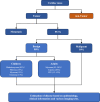Diagnosis and treatment of cardiac tumors
- PMID: 40095104
- PMCID: PMC11914324
- DOI: 10.1007/s12032-025-02661-0
Diagnosis and treatment of cardiac tumors
Abstract
Cardiac tumors, though rare, present significant diagnostic and therapeutic challenges due to their diverse nature and potential severity. These tumors, which can be primary or metastatic, are often detected incidentally through imaging modalities such as echocardiography or CT scans. Differentiating between benign and malignant forms is crucial for guiding appropriate management strategies. This review synthesizes current diagnostic approaches and treatment modalities for cardiac tumors, with a focus on the role of imaging techniques like UCG, CT, MRI, and PET in tumor characterization. Multidisciplinary treatment plans are necessary, including surgical resection for benign tumors, chemotherapy, and radiotherapy for malignant tumors, and novel targeted therapies such as MDM2 inhibitors for selected cases. While primary malignant tumors like sarcomas and mesotheliomas exhibit rapid progression and poor prognosis, recent advances in multimodal therapy offer potential improvements in survival. The incidence of primary cardiac tumors is low, with an autopsy-reported occurrence rate of 0.02%. Benign cardiac tumors, such as myxomas and fibromas, generally have favorable outcomes with surgical resection. In contrast, primary malignant tumors like sarcomas and mesotheliomas exhibit rapid progression and poor prognosis, necessitating aggressive treatment including surgery, chemotherapy, and radiotherapy. Metastatic cardiac tumors occur in approximately 10% of cancer patients at autopsy and are managed according to the treatment plan for the primary malignancy. The management of cardiac tumors requires a multidisciplinary approach tailored to tumor type, location, and systemic effects. While benign tumors often respond well to surgical management, malignant and metastatic tumors demand more complex strategies to optimize patient outcomes.
Keywords: Benign tumors; Malignant soft tissue sarcoma; Metastatic cardiac tumors; Primary cardiac tumors.
© 2025. The Author(s).
Conflict of interest statement
Declarations. Conflicts of interest: No potential conflict of interest relevant to this review was reported. Ethical approval: Not applicable. Consent for publication: Not applicable.
Figures

References
Publication types
MeSH terms
LinkOut - more resources
Full Text Sources
Research Materials

